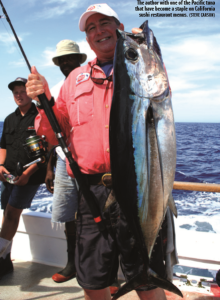FINALLY, AN EASYTO-SWALLOW RULE
TUNA FILLETERS NOW REQUIRED TO KEEP COLLAR COVETED BY SUSHI CHEFS; GEAR UP FOR LONG TRIPS
By Steve Carson
What the heck is “tuna kama?” New filleting regulations for all tuna species caught in California waters require that the fillets must have the skin left on, and the fish’s “collar,” which includes the pectoral fin, be included in the bag together in order to allow enforcement personnel to easily determine species.
For decades before this, deckhands have simply been discarding these collars as waste, often just tossing them overboard and saving only the prime fillet. As it turns out, we should have been saving them all along, as the collar section, or kama, is highly desired by chefs around the world.
At least in California’s high-end sushi bars, it is most often seen as hamachi kama, which comes from yellowtail (hamachi). However, the kama from bluefin tuna (maguro) is usually quite expensive, and so is not often seen stateside. A popular Los Angeles-based foodie site, Chowhound, explained it thusly:
“It would be highly unlikely to find a true, bona fide maguro collar, unless you’ve got some serious fish market connections. The maguro collar is one of the most highly prized, selected cuts from an increasingly rare and highly valuable fish, the bluefin tuna. Its appearance, texture and flavor, surprisingly, approximate that of wagyu beef. Demand far exceeds supply, especially among upper-echelon sushi bars and restaurants, particularly in Japan.”
“If you have enjoyed a meal that included genuine maguro collar, do consider it one of those meals of a lifetime. For home preparation, fresh yellowtail collar may well have to suffice. If not, the search is on, and do expect to dearly reward the purveyor if and when found.”
Another popular foodie site, the Japanese Food Report, had this to say about roasted tuna (maguro) collars:
“Here’s why you need to befriend your local fishmonger, and fast: tuna collar. While here in America we typically eat fish as boneless filets, I’ve learned that in Japan it’s more often enjoyed on the bone, and for good reason. Like a T-bone in a steak, bones in fish impart incredible flavor to the flesh.”
 “And there’s another reason fish on the bone is popular in Japan: chopsticks. Chopsticks are extremely precise instruments that can pick out morsels of food a clunky fork could never reach, such as around bones! With chopsticks, eating fish on the bone is a joy. This is one piece of fish you can never find at the fish store, unfortunately. I urge you to try baking tuna collar if you can get your hands on one. Yellowtail collar and salmon collar work wonderfully too.”
“And there’s another reason fish on the bone is popular in Japan: chopsticks. Chopsticks are extremely precise instruments that can pick out morsels of food a clunky fork could never reach, such as around bones! With chopsticks, eating fish on the bone is a joy. This is one piece of fish you can never find at the fish store, unfortunately. I urge you to try baking tuna collar if you can get your hands on one. Yellowtail collar and salmon collar work wonderfully too.”
If these bloggers are correct, a lot of folks are going to be experiencing the meal of a lifetime this year!
LONG-RANGE GEAR CHECK Numerous articles have been written
extolling the virtues of specialized extra-heavy tackle for chasing “cow” grade yellowfin tuna – those over 200 pounds – aboard San Diego-based long-range boats. The reality is that cow-size tuna are virtually never caught on trips shorter than 10 days’ duration. From now until the end of October, most long-range boats will be running trips between three and eight days in length.
The outline below lists the most commonly recommended rod/reel combos for eight-day trips. Good loaner/rental packages are available from the boat or sportfish landings for first-timers, and new long-rangers can ease slowly into the obsessive tackle collecting that grips a large number of practitioners. For trips of five days’ duration or less, the heaviest combo (No. 5 below) will most likely not be needed, though you can never tell for certain. On most boats, trolling tackle and “kite” tackle can be borrowed from the boat when it’s your turn.
- 25- to 30-pound live bait combo reel: PENN Fathom FTH15LD2, PENN Fathom FTH15 Rod: Conventional 7- to 8-footer, rated for 15- to 40-pound lines Applications: Albacore, dorado, wahoo live bait, school-size bluefin and yellowfin tuna live bait
- 40-pound live bait combo Reel: PENN Fathom FTH25NLD2, PENN Fathom FTH30 Rod: As above, but rated 20-50-pound Applications: All-around live bait use for tuna to 50 pounds (single speeds), 100 pounds (two speeds)
- 50-pound jigging combo Reel: PENN U.S. Senator 113N, PENN Fathom FTH40NLD2 Rod: As above, but rated 30-60-pound Applications: Yo-yo jigging for yellowtail and tuna, wahoo bombs/jigs
- 50- to 60-pound live bait combo Reel: PENN Torque 2-speed TRQ40NLD2, PENN International 2-speed 12VSX Rod: Conventional 6- to 7-footers, rated for 30- to 80-pound lines Applications: Larger tuna to 150 pounds with live bait, medium-duty dropper looping
- 80- to 100-pound live bait combo Reel: PENN International 2-speed 16VSX, or 30VSX Rod: Conventional 5½- to 7 footers, such as PENN CARBW760H, rated for 50- to 130-pound lines Applications: Larger-grade tuna to 200 pounds or more; heavy-duty dropper looping CSEditor’s note: The author loves hearing from California Sportsman readers and can be reached at scarson@sunset.net.



